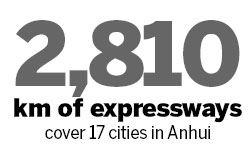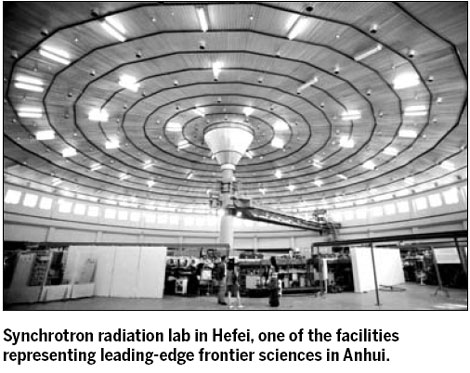|
 |
|
Huangshan Mountain is one of the few tourism destinations in the country that have been designated both a world cultural and natural heritage site as well as a world geopark.
|
During the forthcoming China Anhui Investment and Trade Expo 2010, provincial authorities will also exhibit the abundant resources and recent infrastructure construction to give investors and traders a better understanding of the province's business environment.
Resources
Land: Anhui is fertile and suitable for various crops. Grains are cultivated across 5.73 million hectares.
As an agricultural center, Anhui led rural reforms more than 30 years ago. Today income for farmers has increased as modernization of farms continues.
The output of Anhui's grain, oilseeds and cotton ranks among the top in China.
Human resources: Hefei, capital of Anhui province, was the first pilot city for national science and technology innovation, from which a reservoir of talent has emerged.
Scientific research institutes and schools in the province include the University of Science and Technology of China, the Hefei Institute of Physical Science at the Chinese Academy of Sciences, the Hefei University of Technology and the Anhui University.
Water: About 71.6 billion cubic meters of water is available in the province along with systems for flood control and irrigation.
Animals and plants: Forest coverage across the province totals 3.6 million hectares. Varieties of plants include more than 300 kinds of woody plants and more than 2,100 types of herbs. It is home to more than 500 animal species, including 91 nationally protected animals such as the Chinese alligator and white fin globefish.
Minerals: More than 135 kinds of minerals have been found in the province, 105 of which have verified reserves.
A total of 38 minerals rank the top 10 of reserves in the whole country and 18 of them among the top five. Coal, iron, copper, sulfur and alum are the most important mineral resources in the province.
Science and education: Anhui is ranked among the top for science and technical graduates. By the end of 2008, there were about 1.47 million technical workers and 1,533 scientific research institutions in the province.
Infrastructure
Several exhibitions at the conference will show infrastructure of the province that aids its investment climate.
 |
|
Wuhu Yangtze River Bridge is a transport pivot linking the south and north of Anhui.
|
Highways: Anhui has built 2,810 km expressways covering 17 cities. It takes three hours to drive from west to the east and six hours from north to the south of the province.

Railways: With the rail lines from Beijing-Shanghai, Beijing-Kowloon, Lianyungang-Lanzhou, Nanjing-Xi'an passing through, Anhui has one of the most dense and lengthy rail systems in central China.
With the operation of several high-speed railways that carry the highest-speed trains in China or even in the world linking major cities in neighboring regions, travel from the provincial capital of Hefei to Nanjing takes only an hour. And it takes two hours to Shanghai and Wuhan.
The Anhui section of the Beijing-Shanghai high-speed railway is now under construction, as are the Nanjing-Anqing and Hefei-Bengbu lines. When completed they will shorten the time from Hefei to Beijing to three hours.
Airways: Six airports in Anhui including Hefei, Huangshan and Fuyang, provide direct flights to more than 30 large and medium-sized cities. The Xinqiao International Airport in Hefei is now under construction and is scheduled to be completed in the first half of 2011. Another new airport to be completed in 2011 is located near the tourism resort of Jiuhua Mountains.
Water transportation: Three major river systems flow through Anhui - the Yangtze, Huaihe and Xin'an rivers - that provide potential for further development of inland water transportation.
Ports along the 400 km course of the Yangtze River include Anqing, Tongling, Wuhu, Maanshan and Chizhou.
Posts municationsand telecom: Modern communication systems in Anhui province include a program-controlled telephone network, long-distance digital transmission and mobile communications network.
There were 12.7 million fixed-line telephone users, more than 21.5 million mobile phone users and 2.7 million Internet users across the province at the end of 2009.

By Zhuan Ti (China Daily)
|